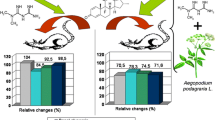Summary
This study investigated the effect of a commercial preparation of stevioside and a synthetic compound, sodium salt of monketocholic acid (MKC), administered per os (p.o.) and also adminstered via an osmotic pump, on glycemia in normoglycemic and diabetic Wistar rats. Diabetes was induced with alloxan, 100 mg/kg, i.p. Normoglycemic and diabetic rats were treated p.o. for five days either with physiological solution (1 ml/kg, controls), stevioside (20 mg/kg), MKC (4 mg/kg) and a combination of stevioside (20 mg/kg) and MKC (4 mg/kg). Apart from p.o. adminstration, stevioside and MKC were also administered via a subcutaneously (s.c.) implanted osmotic pump. During treatment and upon termination of the latter, glycemia was measured and the rats that were treated p.o. were subjected to the oral glucose tolerance test (OGTT) at a dose of 1 g/kg. Following this animals were anesthetized with urethane (0.75 g/kg, i.p.) and killed by cardiopunction to determine C-peptide levels in the serum. In all three groups of normoglycemic rats highest decrease in glucose levels was observed on the fourth day of the experiment. The stevioside + MKC combination showed a stronger hypoglycemic effect compared to individual treatments with stevioside and MKC (3.73:4.80:4.73 mmol/L). In the group of diabetic rats that received both substances via the osmotic pump, the hypoglycemic action was also stronger compared to the individual treatments with stevioside and MKC (16.15:18.89:18.75 mmol/L). The treatment of healthy rats with both substances p.o. caused no statistically significant difference in glycemia, whereas in diabetic rats the combination of stevioside + MKC showed a statistically significant decrease in glycemia compared to control values. In both groups of rats, treatment with stevioside and MKC and their combination prevented an increase in glucose concentrations in the OGTT. Only the administration of stevioside by osmotic pump yielded a statistically significant increase in the concentrations of C-peptide in the serum of healthy rats. Compared to controls, the concentrations of C-peptide in diabetic rats were significantly higher after treatment with either stevioside or its combination with MKC, irrespective of the mode of administration.
Similar content being viewed by others
References
Lappesen P.B., Gregersen S., Alstrup K.K., Hermansen K. (2002): Stevioside induces antihyperglycaemic, insulinotropic and glucagonostatic effects in vivo: studies in the diabetic Goto-Kakazaki rats. Phytomedicine, 9:9–14.
Gregersen S., Jappesen P.B., Holst J.J., Hermansen K. (2004): Antihyperglycemic effect of stevioside in type 2 diabetic subjects. Metabolism, 53:73–76.
Lailerd N., Saengsirisuwan V., Sloniger J.A. (2004). Effect of stevioside on glucose transport activity in insulin-sensitive and insulin-resistant rat skeletal muscle. Metabolism, 53:101–107.
Abudula R., Jeppesen P.B., Rolfsen S.E., Xiao J., Hermansen K. (2004): Rebaudioside A potently stimulates insulin secretion from isolated mouse islets: studies on the dose-, glucose-, and calcium-dependency. Metabolism, 53:137–181.
Fabiani E., Mitro N., Godio C. (2004): Bile acid signaling to the nucleus: finding new connections in the transcriptional regulation of metabolic pathways. Biochimie, 86:771–778.
Raskovic A., Gavrilovic M., Jakovljevic V., Sabo J. (2004): Glucose Concentration in the blood of intact and alloxan-treated mice after pretreatment with commercial preparations ofStevia rebaudiana (Bertoni). Eur. J. Drug Metab. Pharmacokinet., 29:87–90.
Fabiani E., Mitro N., Gilardo F. (2003): Coordinated control of cholesterol catabolism to bile acids and of gluconeogenesis via a novel mechanism of transcription regulation linked to the fasted-to fed cycle. J. Biol. Chem., 278:39124–39132.
Fabiani E., Mitro N., Godio C. (2004): Bile acid signaling to the nucleus: finding new connections in the transcriptional regulation of metabolic pathways. Biochimie, 86:771–778.
Kuhajda K., Kevresan S., Mikov M. (1997): 3α,7α-dihydroxy-12-keto-5β-cholanate as an enhancer of insulin nasal absorption in rats. Arch. Toxicol. Kinet. Xenobiotic Metab., 5:359–361.
Mikov M., Fawcett J.P. (editors) (2007): Bile acids: chemistry, biosynthesis, analysis, chemical and metabolic transformations. Mediset Publisher, Geneva.
Mikov M., Boni N.S., Al-Salami H., Kuhajda K., Kevresan S., Golocorbin-Kon S., Fawcett J.P. (2007): Bio-availability and hypoglycaemic activity of the semisynthetic bile acid 3-alfa, 7-alfa-dihydroxy-12-oxo-5-beta-cholanate, in healthy and diabetic rats. Eur. J. Drug Metab. Pharmacokinet., 32:7–12.
Mikov M., Fawcett J.P., Kuhajda K., Kevresan S. (2006): Pharmacology of bile acids and their derivatives: absorption promoters and therapeutic agents. Eur. J. Drug Metab. Pharmacokinet., 31:237–251.
Mikov M., Fawcett J.P., Kuhajda K., Kevresan S. (2006): Pharmacology of bile acids and their derivatives: absorption promoters and therapeutic agents. Eur. J. Drug Metab. Pharmacokinet., 31:237–251.
Mikov M., Kuhajda K., Kandrac J. (2003): New trends in therapeutic application of bile acids. Med. Pregled, 56:237–242.
Kuhajda K., Kevresan S., Mikov M., Miljkovic D. (2000): Influence of 3-alfa, 7-alfa dihydroxy -12-oxo- 5-beta cholanate on blood glucose levels in rats. Arch. Toxicol. Kinet. Xenobiot. Metab. 8:304–308.
Raskovic A., Jakovljevic V., Mikov M., Gavrilovic M. (2004): Joint effect of commercial preparations ofStevia rebaundiana Bertoni and sodium monoketocholate on glycaemia in mice. Eur. J. Drug. Metab. Pharmacokinet., 29: 83–86.
Jappesen P.B., Gregersen S., Alstrup K.K., Hermansen K. (2002): Stevioside induces antihyperglycaemic, insulinotropic and glucagonostatic effects in vivo: studies in the diabetic Goto-Kakizaki rats. Phytomedicine, 9:73–76.
Author information
Authors and Affiliations
Rights and permissions
About this article
Cite this article
Rašković, A., Mikov, M., Škrbić, R. et al. Effect of stevioside and sodium salt of monoketocholic acid on glycemia in normoglycemic and diabetic rats. Eur. J. Drug Metabol. Pharmacokinet. 33, 17–22 (2008). https://doi.org/10.1007/BF03191014
Received:
Issue Date:
DOI: https://doi.org/10.1007/BF03191014



